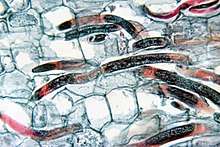Radopholus similis
Radopholus similis is a species of nematode known commonly as the burrowing nematode.[1] It is a parasite of plants, and it is a pest of many agricultural crops. It is an especially important pest of bananas and citrus, and it can be found on coconut, avocado, coffee, sugarcane, other grasses, and ornamentals. It is a migratory endoparasite of roots, causing lesions that form cankers. Infected plants experience malnutrition.
| Radopholus similis | |
|---|---|
 | |
| Scientific classification | |
| Kingdom: | |
| Phylum: | |
| Class: | |
| Subclass: | |
| Order: | |
| Family: | |
| Genus: | Radopholus |
| Species: | R. similis |
| Binomial name | |
| Radopholus similis (Cobb, 1893) Thorne, 1949 | |
History and distribution
The nematode was first described from necrotic tissue in a species of Musa, the banana genus, in 1891. It is one of the most important root pathogens of banana crops,[2] causing yield losses of up to 30 to 60% in many countries.[3] It is known in temperate regions worldwide.[2]
Morphology
Adults and juveniles are vermiform in shape. Adults are sexually dimorphic. The male has a poorly developed stylet, a knob-like head, and a sharp, curved spicule enclosed in a sac. The male is 500 to 600 µm in length, while the female is about 550 to 880 µm long. The female has a well-developed stylet. Both male and female have long, tapered tails with rounded or indented ends.[4]
Biology
The nematode completes its life cycle in about 21 days at 25 °C. [5] Females and juveniles feed inside roots, especially near the tips. Males with their weak stylets do not feed. Females lay two to six eggs per day.[4]
The nematode causes a disease condition called toppling or blackhead disease in plants.[5] In bananas they weaken the anchor roots and the plants can fall. The roots also fail to supply the plant with water and nutrients, causing reduced growth and development.[6]
Management
The nematode load in the soil can be reduced with fumigation and crop rotation. Cover crops that are not susceptible to the nematode, such as Crotalaria or Tagetes, can be sown. Disease-free sprouts raised from clean tissue cultures can be used.
Genetics
It is notable as an early exemplar, along with Radopholus arabocoffeae,[7] of the alternative flatworm mitochondrial code.[8]
References
- Sekora, N. S. and W. T. Crow. Burrowing nematode, Radopholus similis. EENY-542. University of Florida IFAS. 2012.
- O'Bannon J. H. (1977). "Worldwide dissemination of Radopholus similis and its importance in crop production". Journal of Nematology. 9 (1): 16–25. PMC 2620210. PMID 19305565.
- Banana Nematodes: Pests and Diseases of American Samoa. Number 9. American Samoa Community College Community & Natural Resources Cooperative Research & Extension. 2004.
- Brooks, F. E. Burrowing nematode disease. American Phytopathological Society. 2013.
- Luc, M., et al. Plant Parasitic Nematodes in Subtropical and Tropical Agriculture 2nd Ed. Wallingford, Oxfordshire, UK: CABI Publishing. 2005. pg 616. ISBN 9781845931445
- Sarah, J. L., et al. The Burrowing Nematode of Bananas, Radopholus similis Cobb, 1913. INIBAP. 1996.
- https://www.ncbi.nlm.nih.gov/Taxonomy/Browser/wwwtax.cgi?name=Radopholus+arabocoffeae
- Joachim EM Jacob; Bartel Vanholme; Thomas Van Leeuwen; Godelieve Gheysen (2009). "A unique genetic code change in the mitochondrial genome of the parasitic nematode Radopholus similis". BMC Res Notes. 2: 192. doi:10.1186/1756-0500-2-192. PMC 2761399. PMID 19778425.
External links
- Radopholus similis. Musapedia.